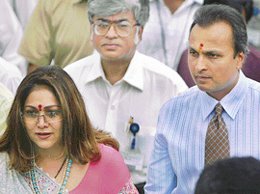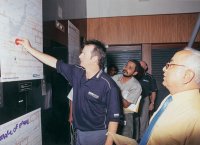
Reliance Connect 2 Life Plan helps you build security & savings for a better tomorrow. As your income is likely to grow, you should also ensure that you have sufficient protection for your near and dear ones. Reliance Connect 2 Life Plan ensures that you have the option to upgrade your life cover to keep pace with your changing lifestyle.
Key Features & Benefits
Maturity Benefit: On survival of the life assured until maturity, the Plan pays the sum assured plus simple vested bonuses to the policyholder.
Death Benefit: In case of unfortunate death of the life assured before the maturity date, the Plan pays the sum assured plus simple vested bonuses to the nominee.
Choice of two plans: At the time of initial purchase of Reliance Connect 2 Life Policy, you have two kinds of plans to choose from namely, Gold Plan and Silver Plan.
The Reliance Connect 2 Life Gold Plan offers a life cover of Rs 2,00,000 initially. You may enhance your life cover to a maximum of Rs 10,00,000 in two stages by exercising your option. The Reliance Connect 2 Life Silver Plan offers a relatively lower life cover of Rs 1,00,000 initially. You may enhance your life cover to a maximum of Rs 5,00,000 in two stages by exercising your option. Options to enhance life cover: Under each of the above two plans, you have an option to enhance your life cover amount:
At the end of one year from the date of initial purchase of Reliance Connect 2 Life Gold / Silver Plan, you are entitled to enhance your life cover by exercising your option to purchase an additional Reliance Connect 2 Life Policy. Provided you have exercised your option to enhance life cover at the end of the first year, you are entitled to enhance your life cover again at the end of the second year by purchasing an additional Reliance Connect 2 Life Policy. For further details on options, please refer to the section on “Other Conditions”
Other Benefits: Reliance Connect 2 Life Plan comes to you with a host of other benefits:
No medical examination and minimal paperwork A profit plan High sum assured rebate for large life cover per policy Policy loan after 3 years Tax benefit under Section 80C & 10(10)D of IT Act Sample Illustration All figures in rupees Plan Types [a] Gold Silver Guaranteed sum assured at maturity [b] 2,00,000 1,00,000 Annual Premium [c] 1,3540 6,820 Non guaranteed benefit at maturity @ 6% p.a. [d] 55,500 27,750 Non guaranteed benefit at maturity @ 10% p.a. [e] 1,27,750 63,750 Total maturity amount @ 6% p.a. [b+d] 2,55,500 1,27,750 Total maturity amount @ 10% p.a. [b+e] 3,27,750 1,63,750 The above maturity benefits are calculated for an illustrative gross investment return of 6% & 10% per annum compounded as stipulated by Insurance Regulatory & Development Authority (IRDA).
Annual Premiums for life assured across different plan options and ages at inception.
Sum insured ------------------- * Age of Entry ------------------- 20 25 30 35 40 Silver Plan Rs 1 lakh 6,742 6,749 6,765 6,820 6,962 Gold Plan Rs 2 lakh 13,384 13,398 13,430 13,540 13,824 * as at last birthday
Maximum allowable sum assured at each enhancement
All figures in rupees Choice of two Plans Gold Plan Silver Plan Sum Assured under policy* at initial purchase 2,00,000 1,00,000 * Maximum additional sum assured under policy+ purchased at the end of one year from date of initial purchase – First enhancement 3,00,000 2,00,000 * Maximum additional sum assured under policy+ purchased at the end of two years from date of initial purchase – Second enhancement 5,00,000 2,00,000 Maximum sum assured allowed per life under all policies+ 10,00,000 5,00,000 * Minimum sum assured at any purchase is Rs 1,00,000. + Policy/policies refer to Reliance Connect 2 Life Policy
Who can buy Reliance Connect 2 Life Plan?
Minimum Maximum Age of entry 18 yrs (For first policy) 45 yrs (For first policy) Age of maturity 33 yrs 62 yrs Policy Term 15 yrs 15 yrs All ages pertain to age on last birthday
Other Conditions:
You have to sign a satisfactory Proposal Form at the time of purchasing each Reliance Connect 2 Life Policy. At the time of exercising your options to purchase additional Reliance Connect 2 Life policies, all previous Reliance Connect 2 Life policies purchased must be in force. If you have not availed of the maximum permissible sum assured in any option, you forfeit the un-availed amount and cannot carry forward the same to future options if any. Premium rates in force at the time of issuing the additional policies and corresponding to the age at the time of purchase, will apply for the sum assured under additional policies. The minimum sum assured under each Reliance Connect 2 Life Policy is Rs 1,00,000. The maximum sum assured under all Reliance Connect 2 Life Plans put together on one life at any time is Rs 10,00,000. The Company reserves the right to ask for further medical or financial information. Other FeaturesLoan against policy: You can take a loan against your policy up to 90% of the surrender value of the policy at the time of taking the loan (based on the terms and conditions at that time).
Built-in ease of pay: For your convenience, we have provided two premium payment modes: Yearly and Monthly. The monthly instalment premium will be 9% of the annual premium.
A multitude of payment methods are available too: Cash, Cheque, Demand Draft, Credit Cards, Electronic Clearing Services (ECS) and R-World (If you have the R-World facility on your mobile phone, you may pay your premiums through your bank account with the banks listed under R-World)
Grace Period: The Company allows a grace period of 30 days (15 days for monthly premium payment mode) from the due date for the payment of premiums.
More value for money (High Sum Assured Rebate): Reliance Connect 2 Life Plan offers an attractive premium discount for sum assured over and above Rs.1,00,000/- per policy at the time of purchase as mentioned below.
Sum assured under policy Rebate per 1000 sum assured Above Rs. 1 lakh; up tp Rs. 2 lakh Rs. 0.50 Above Rs. 2 lakh; up tp Rs. 3 lakh Rs. 0.50 Policy Term Rs. 0.50
Tax Benefit: Premiums paid are eligible for tax deduction under Section 80C of the Income Tax Act, 1961. Maturity & death benefits are tax free under Section 10(10) D of the Income Tax Act, 1961. Under Section 80C premiums up to Rs 1,00,000 are allowed as deduction from your taxable income.
Frequently Asked Questions
What if I do not want to opt for additional life insurance policy? You are eligible for two options to enhance your life cover. However, in case you do not want to enhance your cover, you will still enjoy the benefits of your basic plan. Note that if you do not exercise your first option, you automatically forfeit your second option as well.
What if I want to discontinue the policy?While we advise you against discontinuing the policy as you will be left without valuable insurance protection, we also understand that in situations of financial distress you may want to stop paying future premiums. You have three options:
Lapse the Policy: If less than three years' premiums have been paid and should you decide to stop paying further premiums, your policy will lapse and no benefit will be payable. All premiums paid will be retained by us.
Make the policy Paid up: If you discontinue paying premiums after paying premiums for three full years, then your policy will be converted into a paid up policy for a reduced sum assured determined in the same proportion as the amount of premiums actually paid bears to the total amount of premiums payable. The life insurance protection will continue to the extent of the paid up value until the end of the policy term.The vested bonuses attached to this policy will remain attached in full. Once this policy becomes “paid up”, no further bonuses will be attached to your policy. You will receive the “paid up” sum assured plus bonuses on the maturity date of the policy or in the event of loss of life before the maturity date.
Surrender the policy: Your policy acquires a surrender value after 3 years' premium have been paid and three years have elapsed. We guarantee a minimum surrender value of 30% of the total premiums paid subsequent to the first year premium.On surrender, the insurance protection provided under the policy will also cease.The Company may pay a special surrender value which will be higher than the guaranteed surrender value.
What if I want to revive a paid up or lapsed policy? A paid up or lapsed policy may be revived for full benefits within 5 years from the date of first unpaid premium before the date of maturity, at terms and conditions stipulated from time to time. Currently, you may revive a policy by paying the unpaid premiums with interest at the rate of 9% p.a compounded annually.
General ExclusionWe will not pay any claim on death if the life assured, whether sane or insane, commits suicide within 12 months from the date of issue of the policy or the date of any reinstatement of the policy.
15 Days Free Look PeriodYou are entitled to a free look period of 15 days. If during the 15 days period you do not wish to continue this policy, you may write to the Company to cancel your policy. The Company will refund the premium paid by you after deducting a proportionate premium for the cover provided up to the date of cancellation. The Company will also deduct any medical examination costs, stamp duty charges and other expenses incurred with respect to your policy.
Prohibition of Rebate: Section 41 of the Insurance Act, 1938 states:1) No person shall allow or offer to allow, either directly or indirectly, as an inducement to any person to take out or renew or continue an insurance in respect of any kind of risk relating to lives or property in India, any rebate of the whole or part of the commission payable or any rebate of the premium shown on the policy, nor shall any person taking out or renewing or continuing a policy accept any rebate, except such rebate as may be allowed in accordance with the published prospectuses or tables of the insurer. 2) Any person making default in complying with the provisions of this section shall be punishable with a fine which may extend to five hundred rupees.
Reliance Life Insurance is a Fully Licensed Life Assurance Company registered with Insurance Regulatory & Development Authority (IRDA). Registration No: 121.
For More Detail
Reliance Life Insurance Company Limited,Reliance Life Insurance Advisor :- Dhaivat Trivedi For More Detail :- ADDRESS RELIANCE LIFE INSURANCE CO. LTD. PERFECT POINT, 2nd floor, DR YAGNIK ROAD OPP RAM KRISHNA ASHRAM RAJKOT. - 360002 Tel : 0281 3018008 ,0281 3018009, 0281 3018010, 0281 3018012










